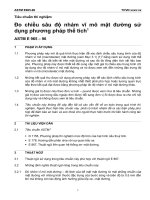Astm e 1008 03 (2009)
Bạn đang xem bản rút gọn của tài liệu. Xem và tải ngay bản đầy đủ của tài liệu tại đây (75.66 KB, 2 trang )
Designation: E1008 − 03 (Reapproved 2009)
Standard Practice for
Installation, Inspection, and Maintenance of Valve-body
Pressure-relief Methods for Geothermal and Other HighTemperature Liquid Applications1
This standard is issued under the fixed designation E1008; the number immediately following the designation indicates the year of
original adoption or, in the case of revision, the year of last revision. A number in parentheses indicates the year of last reapproval. A
superscript epsilon (´) indicates an editorial change since the last revision or reapproval.
kPa (101.5 psi) above the rated working pressure of the valve
assembly at 40°C (104°F) as defined in the latest edition of API
6D.
1. Scope
1.1 This practice covers installation, inspection, and maintenance of valve body cavity pressure relief methods for valves
used in geothermal and other high-temperature liquid service.
The valve type covered by this practice is a design with an
isolated body cavity such that when the valve is in either the
open or closed position pressure is trapped in the isolated
cavity, and there is no provision to relieve the excess pressure
internally.
1.2 This standard does not purport to address all of the
safety concerns, if any, associated with its use. It is the
responsibility of the user of this standard to establish appropriate safety and health practices and determine the applicability of regulatory limitations prior to use.
4.2 The installation shall be such that direct access to the
body cavity is maintained and that the pressure relief device
may be periodically removed, cleaned, inspected, and reinstalled without endangering the operating personnel or removing the valve from its functional application.
4.2.1 The relief device may be mounted with an automatic
shutoff, such as a check valve held in the open position by the
relief device. An example of such an assembly is shown in Fig.
1. The shutoff device will not be rendered inoperative.
5. Cold-Weather Considerations
5.1 Temperatures below freezing are considered due to ice
formation within the body cavity and the associated expansion.
2. Referenced Documents
2.1 API Standard:2
6D—Specifications for Pipe Line Valves, End Closures,
Connectors and Swivels
5.2 The recommended procedures for winterizing (for
example, for temperatures below freezing) valves of the type
described in Section 1 of this recommended practice shall be as
follows:
5.2.1 The valve must be fully closed or fully opened.
5.2.2 The body cavity should be purged with a nonreactive
gas (for example, nitrogen) or filled with a fluid to produce a
solution with a low freezing point (below −45°C (–49°F)).
3. Terminology
3.1 Definitions:
3.1.1 relief device—a spring loaded valve or rupture disk
that will relieve excessive pressure from the body cavity at a
predetermined pressure.
6. Inspection
6.1 The pressure relief device shall be kept clean to ensure
proper operation.
4. Installation
4.1 Any valve conforming to the description in Section 1 of
this practice shall have a body cavity pressure relief device
installed in a manner to relieve excessive pressure from the
body cavity. The relief pressure setting shall not exceed 700
6.2 The relief device shall be removed, inspected, then
cleaned, repaired, or replaced, and reinstalled on a schedule
determined by the respective application. The recommended
inspection period shall not exceed one year.
6.3 If removal of the relief device shall seal the valve body
cavity, (for example, a spring loaded check valve as shown in
Fig. 1) and the working temperature of the valve may change,
then a substitute relief device shall be installed immediately.
1
This practice is under the jurisdiction of ASTM Committe E44 on Solar,
Geothermal and Other Alternative Energy Sources and is the direct responsibility of
Subcommittee E44.15 on Geothermal Field Development, Utilization and Materials.
Current edition approved April 1, 2009. Published June 2009. Originally
approved in 1984. Last previous edition approved in 2003 as E1008–03. DOI:
10.1520/E1008-03R09.
2
Available from American Petroleum Institute (API), 1220 L. St., NW,
Washington, DC 20005-4070, .
6.4 The opening to the valve body cavity shall be inspected
for blockage, and any blockage of scale or any other foreign
material.
Copyright © ASTM International, 100 Barr Harbor Drive, PO Box C700, West Conshohocken, PA 19428-2959. United States
1
E1008 − 03 (2009)
FIG. 1 Assembled Valve-body Pressure-relief Device
6.5 The pressure relief device shall be reinstalled in accordance with this practice.
7. Keywords
7.1 geothermal valve; pressure-relief device
ASTM International takes no position respecting the validity of any patent rights asserted in connection with any item mentioned
in this standard. Users of this standard are expressly advised that determination of the validity of any such patent rights, and the risk
of infringement of such rights, are entirely their own responsibility.
This standard is subject to revision at any time by the responsible technical committee and must be reviewed every five years and
if not revised, either reapproved or withdrawn. Your comments are invited either for revision of this standard or for additional standards
and should be addressed to ASTM International Headquarters. Your comments will receive careful consideration at a meeting of the
responsible technical committee, which you may attend. If you feel that your comments have not received a fair hearing you should
make your views known to the ASTM Committee on Standards, at the address shown below.
This standard is copyrighted by ASTM International, 100 Barr Harbor Drive, PO Box C700, West Conshohocken, PA 19428-2959,
United States. Individual reprints (single or multiple copies) of this standard may be obtained by contacting ASTM at the above
address or at 610-832-9585 (phone), 610-832-9555 (fax), or (e-mail); or through the ASTM website
(www.astm.org). Permission rights to photocopy the standard may also be secured from the Copyright Clearance Center, 222
Rosewood Drive, Danvers, MA 01923, Tel: (978) 646-2600; />
2









